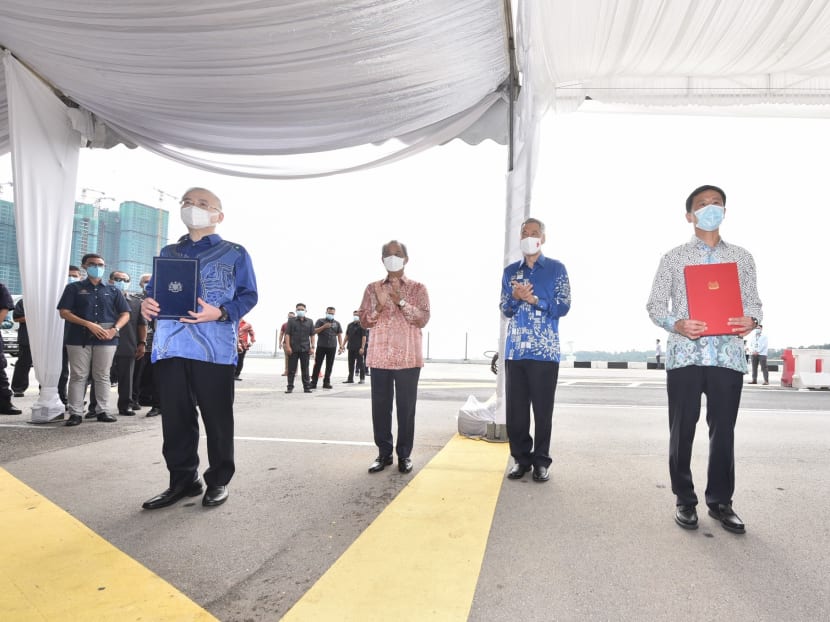Singapore, Malaysia officially resume RTS Link project, completion date set back by two years
SINGAPORE — Singapore and Malaysia have resumed the Johor Baru-Singapore Rapid Transit System (RTS) project, which will now be a standalone light rail transit (LRT) system and expected to start operations by the end of 2026, two years later than initially planned.

Singapore’s Transport Minister Ong Ye Kung (right) and his Malaysian counterpart Wee Ka Siong (left) signed the official agreement to resume the project on July 30, 2020, at a ceremony witnessed by Prime Minister Lee Hsien Loong (second from right) and Malaysian premier Muhyiddin Yassin (second from left).
SINGAPORE — Singapore and Malaysia have resumed the Johor Baru-Singapore Rapid Transit System (RTS) project, which will now be a standalone light rail transit (LRT) system and expected to start operations by the end of 2026, two years later than initially planned.
Singapore’s Transport Minister Ong Ye Kung and his Malaysian counterpart Wee Ka Siong signed the official agreements to resume the project on Thursday (July 30), at a ceremony witnessed by Prime Minister Lee Hsien Loong and Malaysian premier Muhyiddin Yassin.
The RTS Link project has been suspended since April last year at Malaysia’s request, to allow time for the country to review the project.
Both sides have discussed and agreed on some changes to the project:
The RTS Link will be a standalone LRT system, instead of leveraging the Thomson-East Coast Line (TEL) MRT network as initially planned. The RTS Link’s capacity remains unchanged at up to 10,000 passengers an hour for each direction.
The RTS Link will no longer use the existing TEL Mandai Depot and a new depot will be constructed in Wadi Hana, Johor Baru.
Each government on both sides separately appointed an infrastructure company to fund, build, own, maintain and renew the civil infrastructure and stations in its territory up to the international boundary. Malaysia has changed its infrastructure company, from Prasarana Malaysia to Malaysia Rapid Transit System. The Land Transport Authority (LTA) remains as Singapore’s infrastructure company for the project.
The targeted passenger service start date will be deferred from end-2024 to end-2026.
On Thursday, the agreements needed to resume the project were concluded. These were:
An agreement to amend the RTS Link Bilateral Agreement between the two governments
A joint venture agreement between Singapore’s SMRT RTS, a unit of SMRT Corp, and Malaysia’s Prasarana RTS Operations, to constitute RTS Operations
A concession agreement for the Malaysian government and LTA to appoint RTS Operations as the operating company for the first 30-year concession period.
Dr Wee said during a Malaysian parliamentary session last week that the construction of the RTS Link is expected to begin immediately after the necessary approvals are acquired in January next year.
The RTS Link will continue to feature co-location of customs, immigration and quarantine (CIQ) facilities, so that passengers undergo CIQ clearance only once, at their point of departure.
The fare levels will continue to be set by the operating company, and will be determined closer to the date when passenger services begin.
In a joint statement on Thursday, both governments reaffirmed their commitment to ensuring that the RTS Link stations will be well-integrated with the local transport networks in each country.
Mr Ong told the media after the signing ceremony that the RTS Link terminus in Singapore will be next to the Woodlands North MRT Station, which is part of the TEL.
“By the time RTS is opened, commuters can hop off RTS and go straight to Woodlands North station and travel to many parts of Singapore through our MRT system,” he said, adding that the RTS Link should be convenient, efficient and a greener form of transport.
Prime Minister Lee Hsien Loong said that the RTS Link project is valuable not just in terms of how it will ease congestion, but also in how it reflects the ongoing cooperation between Singapore and Malaysia.
"Even during difficult times like now, we are continuing and keeping it going. And there are many other areas where we can cooperate together and do more together," Mr Lee said to reporters after the signing.
When asked about the suspension of the Singapore-Kuala Lumpur High Speed Rail project which has been extended until the end of the year due to changes in Malaysia's government, Mr Lee said that Singapore is studying the proposed changes that Malaysia has provided.
“I hope we'll be able to work something out because the basic thought behind it, that Singapore and Malaysia are two major economies, and Singapore and Kuala Lumpur, particularly, are two cities where there's a lot of to-ing and fro-ing... (so) the more we can make it convenient, I think the more business we can do and the closer the two territories will be in terms of rapport, in terms of cooperation and friendship,” he said.
In attendance at the signing ceremony were also Singapore's Foreign Affairs Minister Vivian Balakrishnan and his Malaysian counterpart Hishammuddin Tun Hussein; former coordinating minister for infrastructure and transport minister Khaw Boon Wan, Malaysia's International Trade and Industry Minister Azmin Ali and the head of government of Johor state Hasni Mohammad.
In response to TODAY's queries on the reason that the RTS link will now be a standalone LRT system, instead of being part of the Thomson-East Coast MRT line as initially planned, a transport ministry spokesperson said: “We were informed that Malaysia was exploring ways to reduce project costs. It had proposed the change in operating system from the TEL MRT system to the LRT system.”
In a report by The Malay Mail, Dr Wee told Malaysian media on Thursday that the entire project will cost about RM10 billion (S$3.24 billion), with Malaysia paying RM3.7 billion, and it will be built in two phases. “The first phase will involve public construction work for four years, followed by the construction of the system for another two years," he said.






